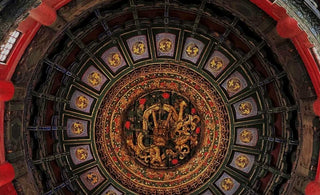
In the vast tapestry of Chinese history, the influence of palace culture on architecture is both profound and enduring. From the regal elegance of the Ming Dynasty to the opulence of the Qing Dynasty, the legacy of these imperial palaces resonates in contemporary design, weaving a narrative that transcends time. This article seeks to delve deep into the lasting impact of Chinese palace culture on architecture, offering a comprehensive exploration of how centuries-old traditions have shaped the buildings we admire today.
The Ming Dynasty: A Legacy of Symmetry and Harmony
The Ming Dynasty, a period marked by stability and cultural flourishing, left an indelible mark on Chinese architecture that continues to captivate the world. Characterized by an emphasis on symmetry and harmony, Ming palaces stand as architectural marvels reflecting the hierarchical order of time. The Forbidden City in Beijing, the quintessential expression of Ming architecture, exemplifies this with its meticulously planned layout, grand halls, and the iconic vermilion and gold color palette that symbolizes imperial power.
The Forbidden City, also known as the Palace Museum, was meticulously designed according to ancient Chinese cosmology and philosophy. The layout, featuring a series of courtyards and halls arranged along a central north-south axis, was believed to align with the cosmic order. The precision in design extended to every detail, from the placement of buildings to the choice of materials, showcasing the Ming Dynasty's commitment to perfection.
Beyond the grandeur of imperial palaces, Ming architectural principles extended their influence to traditional Chinese courtyard houses. The emphasis on interconnected spaces, the strategic placement of courtyards to allow for natural light and ventilation, and the use of wooden structures became defining features of Ming-inspired architecture. The intricate wooden carvings and elaborate roof designs seen in Ming palaces found their way into the architectural DNA of everyday homes, creating a harmonious fusion of aesthetics and functionality.
Transition to the Qing Dynasty: Opulence Meets Functionality
As the Ming Dynasty gave way to the Qing, a new chapter unfolded in Chinese architecture. The Qing emperors, blending their Manchu heritage with Chinese traditions, ushered in a period of opulent grandeur that further enriched the architectural landscape. The Summer Palace in Beijing stands as a testament to this synthesis, a sprawling masterpiece that seamlessly integrates nature and architecture.
The Summer Palace, known for its picturesque Kunming Lake, elegant pavilions, and the iconic Marble Boat, reflects the Qing Dynasty's penchant for blending opulence with functional design. Unlike the Forbidden City's strict adherence to symmetry, the Summer Palace embraces a more naturalistic approach, with meandering pathways, artfully crafted bridges, and strategically positioned pavilions that harmonize with the surrounding landscape.
Qing architecture not only embraced grandiosity but also integrated practical elements seamlessly. Elaborate roof designs served not only as ornamental features but also as functional elements to protect against the elements. Intricate woodwork, often featuring auspicious symbols, showcased the craftsmanship of the time. Expansive courtyards were designed not just for aesthetic pleasure but also for practical purposes, providing spaces for ceremonies, gatherings, and outdoor activities.
This duality of opulence and functionality left an indelible imprint on subsequent architectural styles. The legacy of the Qing Dynasty can be observed not only in grand palatial structures but also in the design of everyday homes. The intricate woodwork, the use of vibrant colors, and the incorporation of natural elements became enduring elements of traditional Chinese architecture.
Legacy in Modern Architecture
The enduring legacy of Chinese palace culture is not confined to the pages of history; it resonates in the very fabric of modern architecture. Architects and designers, both in China and around the world, draw inspiration from the timeless principles embedded in these ancient structures. The use of courtyards as transitional spaces, the incorporation of traditional materials like wood and stone, and the emphasis on flowing spaces that connect indoor and outdoor environments are all echoes of a bygone era that continue to shape contemporary design.
The architectural influence of Chinese palaces is particularly evident in the design of modern institutions and public spaces. Government buildings, museums, and even commercial structures often incorporate elements reminiscent of imperial palaces. The symbolic use of colors, such as red and gold, conveys a sense of authority and tradition. Architectural details, such as upturned eaves and intricate carvings, pay homage to the craftsmanship of the past while creating a sense of cultural continuity.
Oriental Aesthetics: Bridging Tradition and Modernity
In the contemporary landscape, companies like Oriental Aesthetics play a pivotal role in preserving and promoting classical oriental art. By providing systematic, high-quality professional services for oriental artists, collectors, and enthusiasts, they contribute to the continued appreciation of China's rich cultural heritage. Oriental Aesthetics serves as a bridge between tradition and modernity, recognizing the enduring allure of classical art forms while adapting to the evolving needs of a global audience.
Oriental Aesthetics understands that the appreciation of classical art extends beyond the visual to the very essence of cultural identity. The company actively engages in educational initiatives, fostering a deeper understanding of traditional Chinese art forms. Workshops, exhibitions, and collaborations with contemporary artists serve to enrich the dialogue between the past and the present, ensuring that the legacy of Chinese palace culture is not relegated to the annals of history but remains a vibrant and evolving force.
In conclusion, the architectural heritage of Chinese palace culture, from the meticulous symmetry of the Ming Dynasty to the opulent synthesis of the Qing, spans centuries and continues to shape the design principles of contemporary buildings. As we marvel at the architectural wonders of today, we are reminded that every structure carries within it the echoes of dynasties long past, connecting us to the timeless beauty of Chinese palace culture. The enduring legacy of these architectural masterpieces serves as a testament to the rich cultural tapestry of China and the profound impact it has had on the world of architecture.























